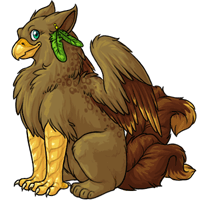


Irion
(EER-ee-on)
Those that live in the Sacred Lands may hold the sheeta in the highest esteem as a work animal, while those on Vetan farms prize the hikei as a sturdy companion. Nothing in Subeta, however, is held in quite the same regard as the irion. Not only do these large beasts make wonderful mounts, but they are quite adept at a number of chores - including pulling sleighs during Luminaire! At first glance, the irion may not seem like the most practical of creatures to keep as a pet, but those that have known the pleasure of an irion's company will say the reward is well worth the work.
Irions are extremely large creatures, standing close to 60 inches (152 cm) at the shoulders. They weigh a surprisingly modest 300 pounds (136 kg) in comparison, as their bodies have had to find ways to adapt to flight. Most of this weight is carried through their strong, broad shoulders and chest, as well as their powerful back legs. Despite this strength, they are quite awkward on ground, especially as youngsters. The irion is much more at home in the sky, where they can fly for several days at a time if needed, stopping only for brief periods of rest. The irion is most at home near mountain lakes, where it can roost on sharp cliffs and windswept banks, but they will make any large high space their home if needed.
Irions live in large flocks, often with several family generations living together. Irions are long-lived and mate for life, although they will only have a small clutch of eggs every few years. These clutches tend to have anywhere from 1-3 large, speckled eggs. Their size prohibits them from building nests in anything but the largest and oldest trees or sheltered cliff edge, and there can be quite a bit of competition for the best nesting spot! Irion hatchlings, known as chiricks, are fully-fledged, although it can take several months for the young to achieve full flight. Their intelligence is well-documented, and they seem to have a certain sentience about them as well. Irions are quite curious creatures, and often appear quizzical, even frazzled at new sights and sounds. Irions are carnivores, preferring fish above other prey. They will not turn down other sources of food, however, and occasionally will even scavenge at a carcass, picking it clean. Perhaps the most unique feature of irions are the feathers they wear on their ears; in the wild, these feathers are gifted from parents to their offspring, with one feather from both mother and father going to each of the young. Domestic irions tend to have flashier feather accessories, provided by their owners - although two is still traditional.
Domestic irions are quite the status symbol, although they are one of the more time-consuming of pets to keep. Because of their tendency to be more comfortable in the air, many owners provide their irions with large towers to rest in, akin to an oversized birdhouse. City dwellers are encouraged to board their irions in the country, and such places exist just for this purpose. The feathers that cover the upper half of an irion's body naturally molt twice a year, and these feathers are sought-after in the furniture and fashion trades. Irion racing is quite a popular hobby, with tracks that consist of both air and land obstacles, providing enrichment for irions and a bonding activity for them to share with their owners.
Irion has been viewed 3,016 times.
[Search]